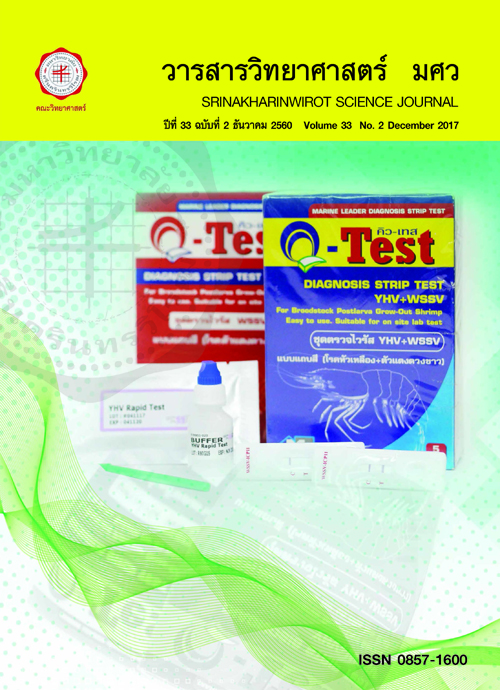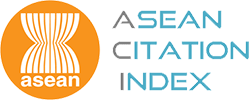พื้นผิวที่ปรับเปลี่ยนระดับความเป็นขั้วได้ของยางธรรมชาติกราฟต์ด้วยพอลิเมทิลเมทาคริเลต
Keywords:
smart materials, natural rubber grafted with polymethyl methacrylate, polymer surfaceAbstract
บทคัดย่อ งานวิจัยนี้พบว่ายางธรรมชาติกราฟต์ด้วยพอลิเมทิลเมทาคริเลต (NR-g-PMMA) สามารถแสดงคุณสมบัติแบบวัสดุฉลาดได้กล่าวคือ พื้นผิวสามารถปรับเปลี่ยนปริมาณหมู่เมทิลเมทาคริเลตได้เองตามระดับความเป็นขั้วของตัวกลางที่สัมผัส ซึ่งสามารถตรวจสอบพฤติกรรมนี้ได้จากการวัดค่ามุมสัมผัสและค่าความแข็งแรงในการยึดติดแบบดึงลอก หลังจากพื้นผิวของ NR-g-PMMA สัมผัสกับตัวกลางที่มีความเป็นขั้วสูง (น้ำกลั่นและแอลกอฮอล์) ค่ามุมสัมผัสปรับลดลงอย่างมากเมื่อเปรียบเทียบกับการสัมผัสกับอากาศซึ่งเป็นตัวกลางที่มีความเป็นขั้วต่ำ ทั้งนี้เนื่องจากหมู่เมทิลเมทาคริเลตซึ่งเป็นโครงสร้างที่มีความเป็นขั้วที่กราฟต์ติดอยู่กับสายโซ่ยางธรรมชาติ สามารถเคลื่อนที่จากใต้พื้นผิวขึ้นมาบนบริเวณพื้นผิวเพื่อลดค่าพลังงานอิสระของพื้นผิวเมื่อสัมผัสกับตัวกลางที่มีความเป็นขั้วสูง นอกจากนั้นค่าความแข็งแรงในการยึดติดแบบดึงลอกของพื้นผิว NR-g-PMMA แสดงการเปลี่ยนแปลงในทิศทางที่สัมพันธ์กับการเคลื่อนที่ของหมู่เมทิลเมทาคริเลตจากใต้พื้นผิวขึ้นมาบนบริเวณพื้นผิวด้วย กล่าวคือพื้นผิว NR-g-PMMA ที่ผ่านการสัมผัสกับน้ำกลั่นและแอลกอฮอล์แสดงค่าความแข็งแรงในการยึดติดแบบดึงลอกสูงกว่ากรณีที่สัมผัสกับอากาศ เนื่องจากอันตรกิริยาที่บริเวณพื้นผิวสัมผัสเพิ่มขึ้นจากการมีหมู่เมทิลเมทาคริเลตมากขึ้น- - -The Tunable Polarity at the Surface of Natural Rubber Grafted with Polymethyl Methacrylate ABSTRACT This research found that natural rubber grafted with polymethyl methacrylate (NR-g-PMMA) could accomplish as smart materials – the amounts of methyl methacrylate groups at its surface adjusted themselves along the levels of polarity of substrates. This surface behavior could be monitored by the measurement of contact angles as well as peeling strength. It was found that surfaces of NR-g-PMMA revealed much lower values of contact angles after equilibration against water and alcohol, which were high polar substrates, compared to that against air which was less polar one. This change was due to the migration of grafted methyl methacrylate group, a polar structure, from the region deep away to the surface of samples in order to minimize the interfacial free energy when contacted against high polar substrates. Moreover, peeling strength at the surface of NR-g-PMMA analogously displayed the same tendency reflecting the mobility of this polar moiety to the surface. This surface exhibited greater peeling strength after equilibration against water and alcohol than that of an air equilibration because of higher interaction created by more amounts of methyl methacrylate groups.Downloads
Download data is not yet available.
Downloads
Published
2017-09-08
How to Cite
คงทอง ส., & โชติรัตน์ ส. (2017). พื้นผิวที่ปรับเปลี่ยนระดับความเป็นขั้วได้ของยางธรรมชาติกราฟต์ด้วยพอลิเมทิลเมทาคริเลต. Science Essence Journal, 33(2), 171–182. Retrieved from https://ejournals.swu.ac.th/index.php/sej/article/view/8633
Issue
Section
Research Article








